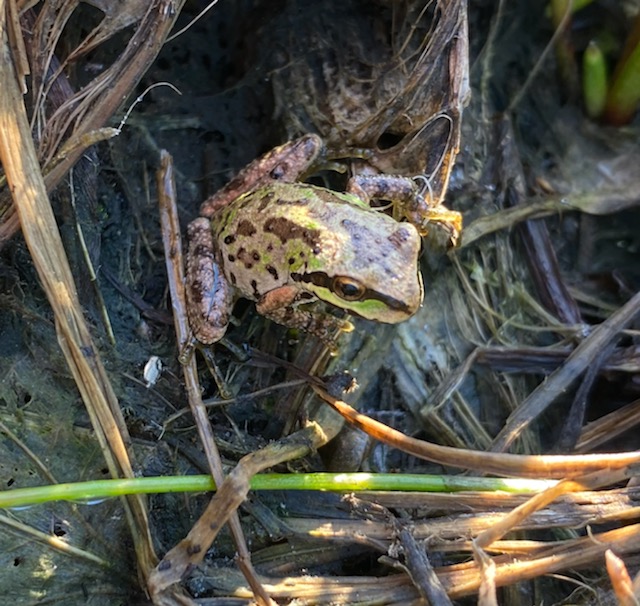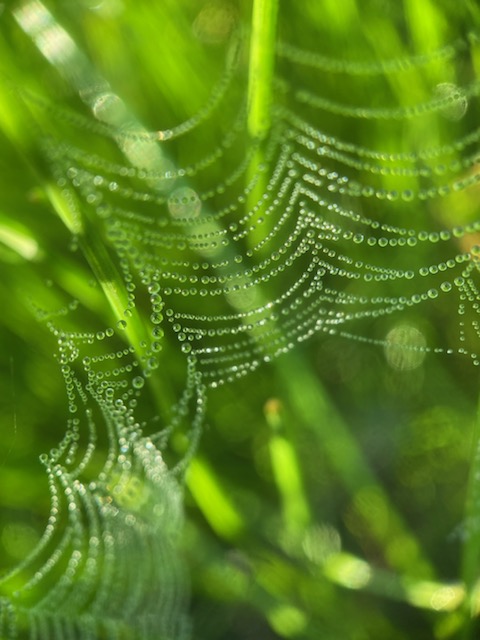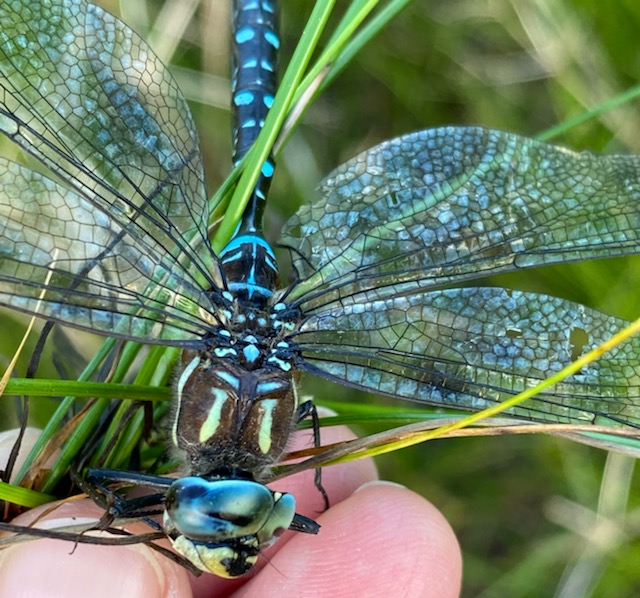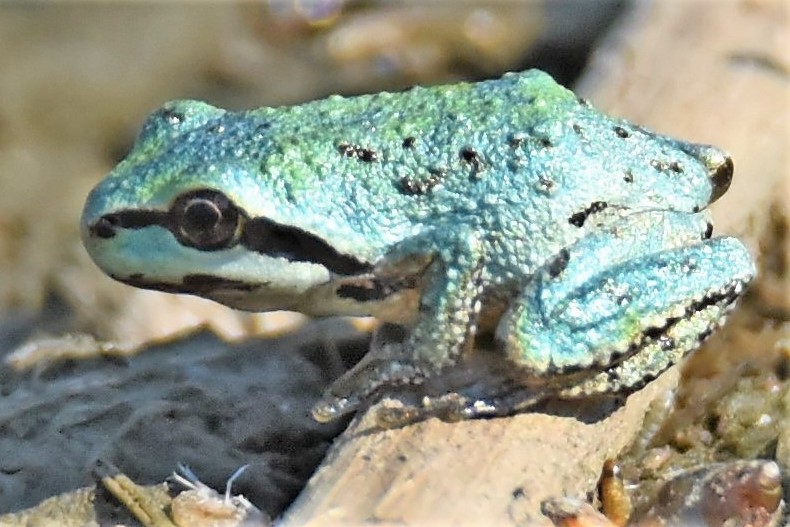The blue frog is out there…somewhere. Photo credit: Jim Diers
The blue frog is my holy grail. Ever since learning that the Northern Pacific tree frog (Pseudacris regilla) can on the rarest of occasions turn up sky blue in color, I have been on the lookout for this near mythological creature. Years ago, Seattle scientist Klaus Richter told me about this phenomenon, which happens when this frog’s typical yellow pigment layer is missing—a genetic aberration that causes it to appear blue.
Never mind the physiological reasoning—the idea of a blue frog haunted me. Its mere existence felt as rare and mystical as a unicorn. Knowledge of it lodged solidly in the back of my mind, prompting a “blue search mode” as I wandered trails around the island and beyond.
I admire the many color variations of this little frog, which can be a gleaming lime green, chocolate brown with stripes, grayish, fawn brown, or even an admirable coppery gold color. Each year, I examine the first frogs emerging from our little pond as they bask on lily pads, their tails still attached. I have seen them exhibit all of these colors and more, but never blue. Then, last month, local photographer and nature lover Jim Diers posted on the Vashon Nature Center Facebook group a photo of a blue frog he had found at Mukai Pond. There was a blue frog on Vashon!

A colorful (though not blue) Northern Pacific tree frog catches a sunbeam. Photo Credit: Kathryn True.
The next morning, I set out with my camera, rubber boots and not a little hope. My spirits flagged only briefly when I reached Mukai—by early fall it had become a vast field of grasses and sedges. The normal expanse of water had shrunk to an area the size of a backyard swimming pool, where a female mallard and great blue heron presided. I started my quest far away from these two, not wishing to disturb their peaceful ablutions.
The first tree frog I encountered was a handsome one—tan and tinged with green, complemented by brown and black spots. The skin was warty, not smooth—yet another variation in these frogs. Though the Northern Pacific tree frog’s signature dark eye stripe remains consistent, their skin color can change within minutes based on air temperature and humidity, which is believed to assist with camouflage.

This frog was a recent morph, going from tadpole to land dweller over the summer, and I admit its size was slightly deflating: It measured no longer than my thumbnail. As I raised my eyes to again survey the sea of green around me, I realized this was most definitely a needle-in-a-haystack situation. But the possibility of beholding a blue frog nudged me forward.
I followed an animal path to the south and soon startled a fat garter snake with yellow stripes. (Did it hold a blue frog within?) The reptile gave me pause as I considered a bright blue creature surviving the hungry hordes that visit the pond daily. To the south, another puddle remained, and at its edges several young Northern red-legged frogs hopped energetically out of my way, melting into the underbrush. Though the same age, these young ones are nearly double the size of our tree frogs, and typically brown to reddish-brown with spots.
As I headed back to the main path, a paddle-tailed darner dragonfly hovered before me with taunting bright blue stripes. I watched it swoop and dive to chase off a foe and return to stare at me questioningly. Its blue accents seemed drawn from the very sky itself—which had an almost iridescent quality in the late September light.

My eyes were again drawn back to the water, where the mallard preened, a peek of her indigo blue wing stripe flashing momentarily. Across the pond, the heron eyed me attentively, her less cosmic blue reflected in the water, a shimmering reminder that blue is blue is blue.
Though I didn’t find the blue frog that day, my heart lifted in a new appreciation for the mysteries that sustain us and the magic of life in our midst. It is a soul-sustaining proposition, and I left thinking that a quest that continues is perhaps even more fulfilling than a quest obtained. Perhaps.
Kathryn True is an island writer and a member of the Vashon Nature Center science advisory council.


May your search for blue continue. The journey is blue-tiful!
Thank you, Emilie! Looking forward to searching with you.
But what happens if you lick the elusive blue frog?
What happens if you lick a green one, Andre!?
I hope your search for this fabled blue frog ends in success! Happy hunting!
Thank you!
Just took a picture of one on our front porch in Gearhart, OR. Really cool looking
That’s great! How lucky!
I found a blue tree frog in Hillsboro Oregon at the wetlands it was amazing!
thats rad dude
I saw a blue tree frog in one of our potted plants in summer of 2023- then this summer (2024) I saw another near out veggie garden – it looked smaller than the previous one